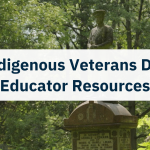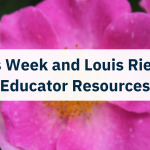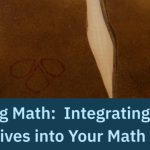How to Decolonize and Indigenize Your Teaching
As classroom teachers, finding ways of decolonizing and Indigenizing our classrooms can be challenging. We’re no strangers to our provincial curriculums outlining these expectations, but how can we do this in a meaningful and authentic way?
In this post, we discuss the difference between decolonizing and Indigenizing and share strategies for implementing these processes in the classroom.
Understanding the Difference Between Decolonization and Indigenization
Understanding the difference between decolonization and Indigenization is an excellent place to start.
Decolonization breaks down long-held colonial ideologies embedded in our teaching practices and curriculum. Indigenization builds environments that respect, reflect, and integrate Indigenous ways of knowing and being. We must decolonize to make space for Indigenization.
How Do I Decolonize My Teaching Practice?
Engage in Personal Reflection
One of the first steps you can take is to reflect on cultural biases, assumptions, and privileges. Asking yourself reflective questions can be a powerful way to start this practice. Here are some questions to guide your self-examination:
- How do my personal experiences and background shape my understanding of different cultures and histories?
- In what ways might my unconscious biases affect my interactions with students?
- In what ways might my unconscious biases come through in the course materials I choose to use in the classroom?
Identifying and unlearning your unconscious biases can feel like a challenging prospect. This interview with Dr. Susan Dion, a Lenape and Potawatomi professor at York University, is another great introductory resource as you begin this journey. She discusses how she helps teachers investigate and deconstruct their biographies of Indigenous people and cultures.
Decolonize the Curriculum
After engaging in personal reflection, you can then consider ways to decolonize your curriculum, pedagogy, professional development, and student engagement. Here are some questions to guide this professional growth:
- Whose voices and perspectives are represented in the curriculum and materials I use? Are there any voices that are missing or marginalized?
- How do my teaching methods accommodate diverse learning styles and cultural backgrounds?
- In what ways do I encourage students to question and critically analyze information?
- How can I build relationships with local communities, particularly those that are Indigenous or marginalized?
- How do power dynamics in my classroom affect student learning and participation?
- What steps can I take to create a more equitable and inclusive classroom environment?
- How will I continue to reflect on and revise my teaching practices to ensure ongoing progress?
Decolonization is a lifelong process. Regularly engage with these types of questions, critically examine your teaching practice, and actively work to improve it to make your classroom a more inclusive and equitable space for all students.
Strategies for Indigenizing Your Classroom
There are many different ways to Indigenize your classroom. Here are a few steps you can take.
Understand Whose Territory You’re On
Acknowledging the historical presence of Indigenous communities on or near your school is a great first step. Territory acknowledgements are one way we can undo Indigenous erasure and bring awareness to Indigenous Peoples and Treaty Rights. Native Land is an interactive world map of Indigenous territories, treaties, and languages. They also have educational resources on how to approach territory acknowledgements and how to help students think critically about maps.
Use this resource to support your students in co-creating an acknowledgement for the area they live in. Without deep understanding and commitment to continued learning, territory acknowledgements can quickly become lip service or a “stand-in” for reconciliation without action. Ensure you feature this acknowledgement in a prominent spot in your classroom, engage with students regularly about the purpose of the acknowledgement, and incorporate other strategies to ensure there is an ongoing Indigenous presence in your classroom.
Include Indigenous Perspectives and Stories
Ensure there are Indigenous authors and voices in your reading lists. Canada has an array of exceptional Indigenous authors, offering literary pieces for all age groups. Stories are excellent conversation-starters. They allow students to reflect on why an author has written a given story and articulate the lessons they draw from the story or characters.
Check out this list of books for kids and teens written by Indigenous authors: 20 books for kids and teens to read for National Indigenous History Month.
Include Subject-Specific Resources
In addition to bringing stories by Indigenous authors into the classroom, you can include Indigenous perspectives in subjects like history, social studies, math, science, and art to help promote respect and appreciation for Indigenous cultures and the land. Lessons can explore the traditional uses of local plants, the significance of storytelling and sharing of knowledge, the stories embedded in the landscape, and traditional ways of living off the land, ultimately fostering a deeper connection to the land we live, learn, and play on.
Indigenizing curriculum in this way also presents a great opportunity to engage with local Indigenous organizations, Elders, and Knowledge Keepers who can provide valuable insights and authentic perspectives on traditional topics. Whether a community member has accepted an invitation to your classroom or recommended several authentic resources, ensure you follow the correct Protocols. If you’re not familiar with the appropriate Protocols or unsure where to start, reach out to your local Friendship Centre.
An easy step is to find and follow the websites or social media of any local Nations, treaty areas, or Indigenous groups.
Create an Inclusive Classroom Calendar
One final recommendation is that teachers create an inclusive classroom calendar with important cultural dates and community events. These events offer valuable learning experiences for your students and their families. Community engagement is also a crucial part of creating inclusive and supportive learning environments for Indigenous students.
Here are a few to get you started:
| Month | Topic |
|---|---|
| January | National Storytelling Week (dates vary) |
| March | National Indigenous Languages Day (31) |
| May | National Day of Awareness for Missing and Murdered Indigenous Women and Girls Red Dress Day |
| June | National Indigenous History Month and National Indigenous Peoples Day |
| September | National Day for Truth and Reconciliation Day / Orange Shirt Day |
| October | Secret Path Week (17-22) |
| November | Rock Your Mocs Week (dates vary) |
Decolonizing our teaching and Indigenizing our classrooms creates richer learning experiences for both Indigenous and non-Indigenous students. When educational environments reflect the diverse cultures, histories, and experiences of Indigenous Peoples, it helps Indigenous students feel acknowledged and valued. This not only enhances their sense of belonging but also fosters a more meaningful educational experience. The resources below can support you throughout this journey:
- Decolonizing Teaching, Indigenizing Learning – The University of British Columbia Curriculum Bundles
- School of Public Health Sciences – University of Waterloo – Resources for instructors to decolonize and Indigenize teaching and learning
- Office of Teaching and Learning – University of Guelph: Decolonizing the Classroom through Indigenous Education








